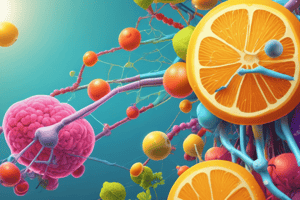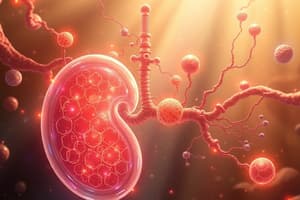Podcast
Questions and Answers
What is the role of NAD+ in cellular respiration?
What is the role of NAD+ in cellular respiration?
- Produces carbon dioxide from citrate
- Generates a proton gradient
- Forms GTP from ATP
- Converts into NADH (correct)
Where does oxidative phosphorylation take place?
Where does oxidative phosphorylation take place?
- Mitochondria (correct)
- Endoplasmic reticulum
- Cytoplasm
- Nucleus
What is the primary outcome of the electron transport chain?
What is the primary outcome of the electron transport chain?
- Production of carbon dioxide
- Creation of a proton gradient (correct)
- Formation of GTP
- Synthesis of ATP
How does cellular respiration relate to the production of ATP?
How does cellular respiration relate to the production of ATP?
What factors influence cellular respiration efficiency?
What factors influence cellular respiration efficiency?
What is the initial stage of cellular respiration?
What is the initial stage of cellular respiration?
How many ATP molecules are generated during glycolysis?
How many ATP molecules are generated during glycolysis?
Where does pyruvate oxidation occur?
Where does pyruvate oxidation occur?
What is the product of pyruvate oxidation?
What is the product of pyruvate oxidation?
Which stage of cellular respiration is also known as the TCA cycle?
Which stage of cellular respiration is also known as the TCA cycle?
What is the main purpose of cellular respiration?
What is the main purpose of cellular respiration?
Flashcards are hidden until you start studying
Study Notes
Cellular Respiration
Understanding the Basics
Cellular respiration is a biological process that involves the breakdown of nutrients, such as glucose, into simpler substances to release energy in the form of ATP (adenosine triphosphate). This process is essential for living organisms to maintain vital functions and to survive. Cellular respiration consists of four main stages: glycolysis, pyruvate oxidation, the citric acid (Krebs) cycle, and oxidative phosphorylation.
Stages of Cellular Respiration
- Glycolysis: This is the initial stage of cellular respiration, which occurs both in eukaryotes and prokaryotes. Glucose, a six-carbon sugar, is converted into pyruvate, a three-carbon molecule. Two ATP molecules are consumed, but four ATP molecules are generated during this process. Additionally, NAD+ is converted to NADH, and two ATP molecules are formed by substrate-level phosphorylation.
- Pyruvate Oxidation: Pyruvate, the product of glycolysis, enters the mitochondria and is further processed. Here, it is converted into two-carbon acetyl-CoA, which then enters the TCA cycle. The remaining two ATP molecules generated in glycolysis are conserved through a process called substrate-level phosphorylation within the mitochondria.
- Citric Acid (Krebs) Cycle: Also known as the TCA cycle, it is a cyclic biochemical reaction that starts with the combination of acetyl-CoA and oxaloacetate, yielding citrate. As the cycle progresses, NAD+ is converted into NADH, flavin adenine dinucleotide (FAD) becomes FADH2, and guanosine triphosphate (GTP) is formed from ATP. The cycle ends with the production of two carbon dioxide molecules from citrate, releasing energy in the process.
- Oxidative Phosphorylation: This stage occurs within the mitochondria, where electrons from NADH and FADH2 pass through the electron transport chain, generating a proton gradient across the inner membrane. This gradient drives the synthesis of ATP via oxidative phosphorylation, leading to the formation of adenosine diphosphate (ADP) to ATP, releasing the stored chemical energy.
Factors Affecting Cellular Respiration
Cellular respiration is influenced by factors such as temperature, pH, substrate concentration, and the presence of inhibitors. Any factor that affects cellular respiration directly impacts how efficiently ATP is produced, ultimately affecting the organism's ability to carry out essential functions.
Studying That Suits You
Use AI to generate personalized quizzes and flashcards to suit your learning preferences.




